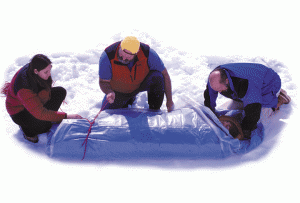
This year, the cold has been much more than a mere nuisance, given the early-January polar vortex that affected many Americans. When temperatures drop, the shivers, the goosebumps, and the numb fingers are all too apparent. But looking deeper, there are many fascinating and unexpected ways that cold affects the internal human body. Some of these lesser-known effects of cold include rerouted blood flow and irrational undressing behaviors, along with other forms of impaired decision-making.
In cold temperatures, the body’s primary goal is to keep its vital organs warm. The region of the brain responsible for temperature regulation, the hypothalamus, diverts the vast majority of blood flow away from non-essential extremities in an effort to keep the critical core functioning. This process is achieved through vasoconstriction, in which veins constrict to prevent blood flow to the arms, legs, nose, and ears. This shunting of blood away from the extremities is what causes frostbite. The lack of warm circulating blood causes tissues in the arms, legs, nose, and ears to freeze, rupture, and die.
An odd consequence of this vasoconstriction is that it causes people to have to urinate more often. When the hypothalamus reroutes blood towards the internal organs, the kidneys receive greater blood flow. With more blood flowing through them, the kidneys produce more urine than usual.
A more extreme outcome of cold temperatures is hypothermia, which is especially dangerous because people are typically unaware when it begins. Hypothermia occurs when the body’s core temperature decreases to a point where metabolism slows down and mental acuity and muscular functions are impaired. The body functions optimally at 98.6 degrees Fahrenheit; even at 97 degrees, survival instincts falter and judgment deteriorates. Interestingly, as victims become more hypothermic, they become increasingly self-destructive, unable to help themselves.
Hypothermia also causes what rescuers call the “umbles.” First, when the body reaches 96 degrees, the victim begins to stumble and fumble as coordinated muscular activity begins to falter. By 95 degrees, the grumbles and the mumbles have set in due to decreased brain activity. Amnesia eventually takes its toll as well, making it more difficult for victims to get themselves to safety. Victims’ minds slow, and sleepiness and hallucination become common.
Bizarrely, when victims reach extremely low body temperatures, they often begin taking off all of their clothing. This “paradoxical undressing” is thought to cause the death of between 20 and 50 percent of hypothermia victims, and scientists have yet to definitively determine why it happens.
One proposed theory is that the muscles that had been limiting blood flow to the extremities become exhausted. This causes a sudden influx of blood — and thus also heat — to the extremities. Combined with their existing irrationality, victims feel panicked by what they perceive as overheating, and thus start to remove their clothes.
The risk of hypothermia varies greatly depending on the type of activity that a person is doing. Runners, skiers, and bikers are more at risk than walkers and hikers because their pace is faster and they are thus exposed to greater wind chill. Athletes can also experience a sharp decline of core temperature in the cold, because they expend a lot of energy.
Alcohol consumption also poses an added danger in cold weather in that it acts as a vasodilator. This means that it acts against vasoconstriction and increases blood flow to the extremities, which makes a person feel warmer even though they are losing heat more quickly.
So, how cold is too cold? It is hard to say. Scientists cannot experiment on people due to bioethics constraints, and results from animal testing do not really translate to the human condition due to varying metabolisms between species. Still, experts agree that a wind chill below 50 degrees Fahrenheit, a temperature that many Americans experienced during the polar vortex, can cause frostbite in less than five minutes.
Experts warn that temperatures do not have to be extremely cold for dangerous effects to occur. If the body is exposed for long enough, dropping temperatures can cause physical and mental disasters. The body has many coping mechanisms, but the best way to avoid hypothermia is to stay in a group. It is difficult to notice the progress of hypothermia when alone, but others can easily observe the symptoms and prevent its occurrence. Only by better understanding the impact of the cold on decision-making will people really be protected against frigid winters.
